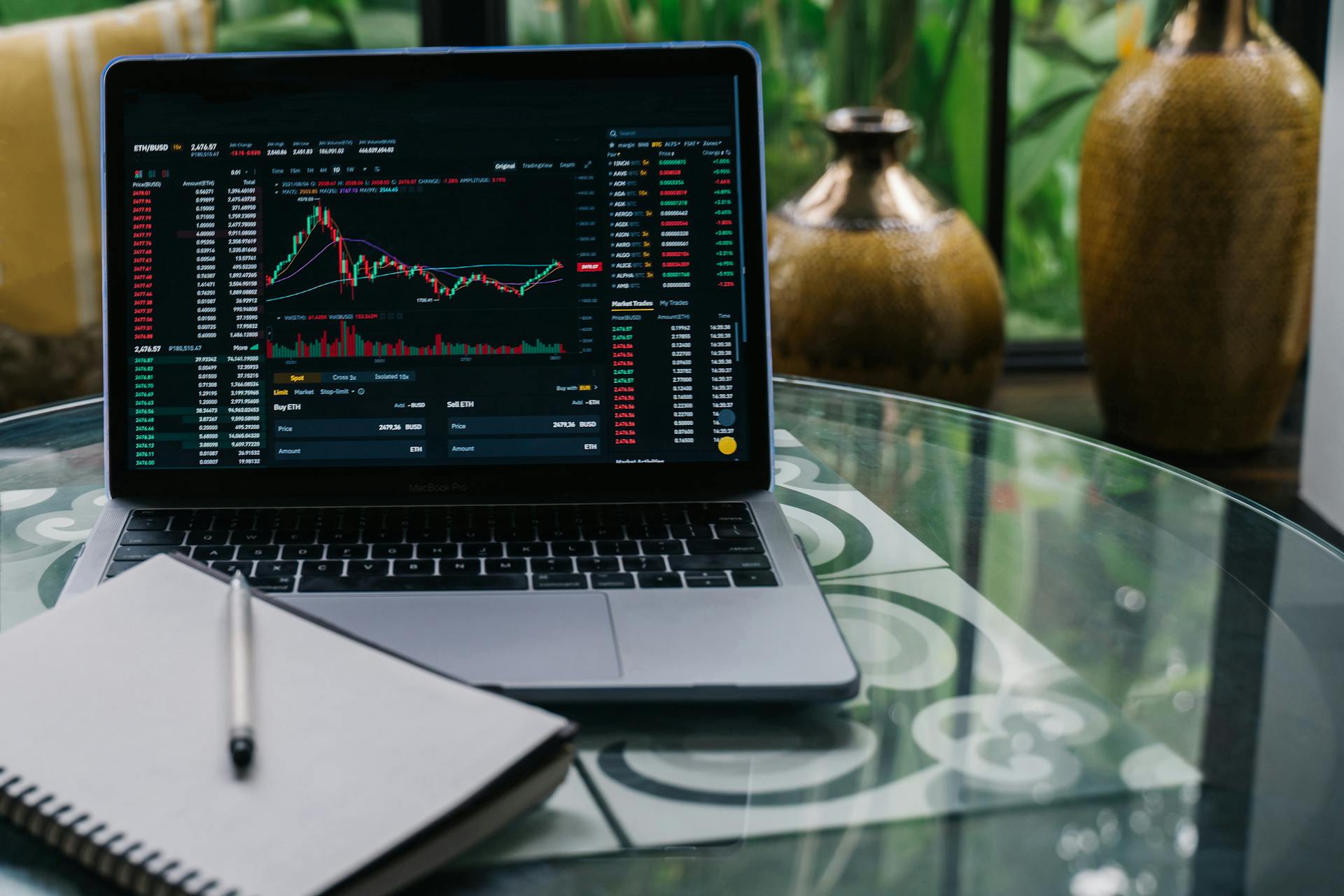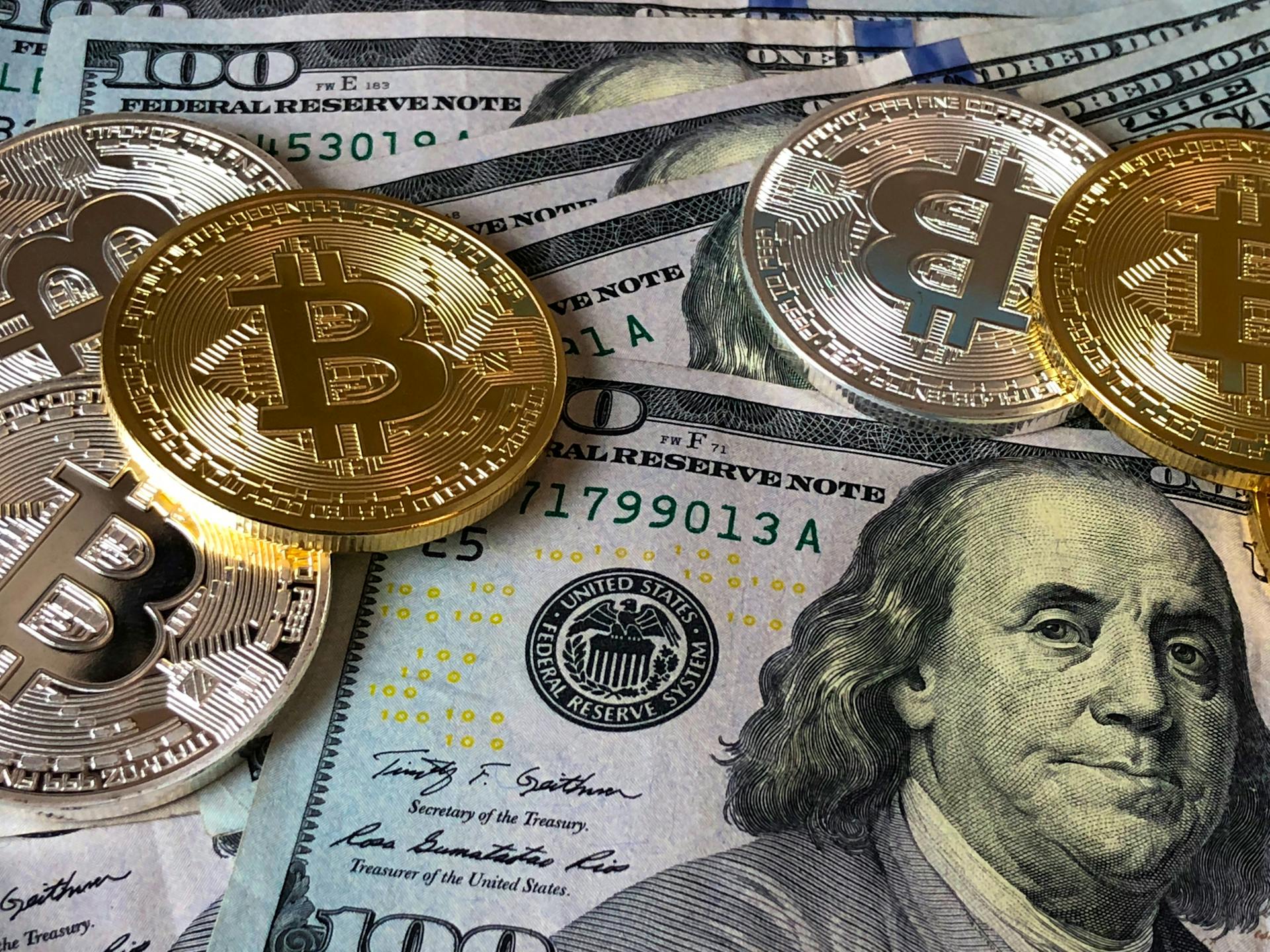
In today's high interest rate environment, savvy investors are looking for ways to maximize their returns.
High-yield savings accounts can earn up to 4.5% APY, providing a safe and liquid option for short-term investments.
For those willing to take on slightly more risk, certificates of deposit (CDs) can offer returns of 5% or more, depending on the term length.
Investors can also consider peer-to-peer lending, which can generate returns of 6% or more, although this option comes with higher credit risk.
You might like: Bank Interest Rates for Term Deposits Nz
Investment Types
Investing in stocks can be a good option even in a high-interest rate environment, as some sectors tend to perform better than others. For instance, utilities, energy, consumer goods, and foods have historically outperformed in rising rate environments.
Utilities have seen an annual return of 8.4% when rates are rising, making them a strong contender for investors. Energy and consumer goods have also performed well, with annual returns of 7.9% and 7.8% respectively. Foods have followed closely behind with an annual return of 6.5%.
These sectors tend to do well because people need to eat, put gas in their cars, brush their teeth, and heat their homes regardless of the direction of interest rates.
Intriguing read: Difference between Annual Percentage Yield and Interest Rate
Bond
Bonds are a type of investment that can provide a predictable source of income, making them a great option for those seeking stability.
Bonds are essentially loans to governments or corporations, which are then repaid with interest. Treasuries, issued by the U.S. government, are considered the safest type of bond, while corporate bonds offer higher interest but come with a higher risk of default.
Investors can earn interest on bonds, which is typically paid semiannually. The interest rate is set at auction, and the price of the bond may be more or less than its face value, depending on the yield to maturity and interest rate.
The yield to maturity is the annual rate of return on the security, and it's calculated by dividing the coupon price by the bond price and multiplying by 100. For example, if you purchased a bond at a price of $102.51 with a coupon of 5.25%, your interest yield would be 5.12%.
For more insights, see: Coupon vs Interest Rate
Bonds with high yields, often referred to as "junk bonds", have a greater risk of default but also offer strong profit potential. On the other hand, bonds with low yields, such as Treasuries, are considered safer but offer lower returns.
Here's a comparison of bond and note characteristics:
In both examples, the yield is higher than the interest rate, resulting in a lower price than par value.
Dividend
Dividend is a type of income-generating investment where you receive regular payments from the company. This can be a great option for those looking for a relatively stable source of income.
A dividend stock is a type of investment that pays out a portion of the company's profits to its shareholders. This can be a great way to earn a regular income, as dividend stocks tend to do well in environments where interest rates stay high.
To calculate the dividend yield of a stock, you divide the dividend per share by the current stock price and multiply by 100. For example, if a company pays $2.00 in annual dividends and its current stock price is $50.00, the dividend yield would be 4%.
For your interest: Commerical Mortgage Rates
You can also invest in a fund that holds dividend-paying stocks, which can help reduce your risk through diversification. This means you won't get hurt if some companies have to cut their dividend or see their businesses suffer.
Here's a breakdown of how dividend yield changes with stock price:
As you can see, dividend yield decreases with increasing stock price and increases with decreasing stock price. This means that a high yield may not always translate to a profitable investment, and you should do your due diligence to avoid falling prey to yield traps.
Top-Performing: Value Firms
Value firms tend to perform well in restrictive monetary environments. These firms have relatively low price multiples, strong cash positions, and low debt ratios.
Specifically, Johnson found that value firms with these characteristics tend to be the top-performing firms during restrictive monetary periods. He notes that firms with more risk elements and greater growth prospects tend to perform better during expansive environments.
Consider reading: Value Investing
Value firms often trade at low multiples of earnings and cash flow, making it easier to earn back your investment if the company can maintain its profitability. This is especially true in a higher interest rate environment where investors are looking for companies with strong cash flows.
Investors may want to tilt their equity portfolios to firms with these characteristics when interest rates are rising. This could be a good strategy for equity investors looking to adapt to changing interest rates.
Recommended read: Interest Rate Impact on Equity Market
Investment Strategies
For short-term, income-focused investors, prioritize dividend-paying stocks and high-yield but low-risk bonds to generate passive income for everyday activities.
Consider investing in sectors that perform well during rising interest rates, such as utilities, energy, consumer goods, and foods, which have annual returns of 8.4%, 7.9%, 7.8%, and 6.5% respectively.
Stocks in the utilities sector, for example, have an annual return of 8.4% during rising interest rates, making them a potentially attractive option for investors.
Suggestion: What Is Apy in Banking Terms
Low Risk Strategies
High-yield investments offer a shot at financial security, providing you with the passive income needed to finance your everyday activities.
To prioritize low-risk investments, focus on high-yield but low-risk bonds, such as municipal bonds, which can deliver tax equivalent yields that are higher than taxable yields.
High-yield savings accounts and CDs offer low risk, making them suitable for short-term, income-focused investors.
You can also consider Treasury Inflation-Protected Securities (TIPS) to hedge against an inflationary or deflationary economy.
Low-risk investments like Treasuries, corporate bonds, and individual company stocks represent different levels of risk, so it's essential to consider your risk appetite when making decisions.
A 3% tax-free municipal bond yield equates to a 4.2% taxable yield for those in the 28% federal income tax bracket, and 4.5% for those in the 34% bracket.
Diversifying your fixed-income investments can help smooth out turbulent markets, so consider including a range of bonds, such as Treasuries, corporate bonds, U.S. bonds, foreign bonds, taxable bonds, municipal bonds, short-term and longer-term bonds, in your strategy.
For another approach, see: Treasury vs Corporate Bonds
Diversify Investments, Too
Diversification is key to a smooth ride in turbulent markets. It helps you avoid putting all your eggs in one basket and reduces your risk of significant losses.
Investors should diversify their fixed-income investments by including a mix of Treasuries, corporate bonds, U.S. bonds, foreign bonds, taxable bonds, municipal bonds, and short-term and longer-term bonds. This way, you're not relying on a single type of investment to perform well.
Diversification also helps you smooth out market fluctuations and avoid timing the market. You can't predict when one investment will outperform another, so it's best to have a balanced portfolio.
Tax equivalent yields are another crucial aspect to consider when investing in municipal bonds. For instance, a 3% tax-free municipal bond yield is equivalent to a 4.2% taxable yield for those in the 28% federal income tax bracket, and 4.5% for those in the 34% bracket. This highlights the importance of considering tax implications when investing in municipal bonds.
On a similar theme: 5 3 Bank Money Market Interest Rates
Investment Considerations
High interest rates can significantly impact your investment portfolio, making it essential to consider the right strategies. Certain sectors tend to perform better during rising rate environments.
Utilities, energy, consumer goods, and foods are among the best-performing sectors when rates are rising, with annual returns of 8.4%, 7.9%, 7.8%, and 6.5% respectively. People need to eat, put gas in their cars, brush their teeth and heat their homes regardless of the direction of interest rates.
Investors should be cautious of sectors that rely on discretionary spending, as they tend to languish during restrictive periods. Autos, durables, retail, and apparel are among the worst-performing sectors during rising rate environments, with annual returns of -1.3%, 0.1%, 2.8%, and 2.8% respectively.
High-yield investments offer a shot at financial security, providing passive income for everyday activities. Various high-yield assets or investment opportunities exist, from low-risk options like savings accounts and CDs to moderate-risk alternatives like corporate bonds.
Value stocks may do well in a higher interest rate environment, as investors look for companies with strong cash flows and immediate profitability. Value stocks tend to trade at low multiples of earnings and cash flow, making it easier to earn back your investment if a company can maintain the same level of profitability.
Here's an interesting read: Cash Value Life Insurance Interest Rates
Investment Options
High interest rates can significantly impact your investment choices, and it's essential to know which options perform better in a rising rate environment.
Money market funds are a safe and attractive option, offering yields of 5 percent or more as of May 2024. They invest in high-quality short-term securities, providing current income while maintaining stability and liquidity.
Investing in stocks can still be a viable option, despite rising interest rates. Certain sectors like utilities, energy, consumer goods, and foods tend to perform better when rates are rising, with annual returns of 8.4%, 7.9%, 7.8%, and 6.5% respectively.
Additional reading: 5 Year Interest Only Mortgage Rates
Index funds and ETFs can also be a low-risk, high-yield investment option. They offer diversification, protecting your investment against volatility, and can be an efficient and cost-effective way to build long-term wealth.
Investors can earn attractive yields from money market funds as long as rates stay high, making them a decent return for taking very little risk.
If this caught your attention, see: Index Funds Return
Investment Calculations
Calculating your investment yield is a crucial step in determining its worth and comparing different investment options. To calculate yield, you divide your income (dividend or interest) over a set timeframe by either its current price or your principal.
The specific parameters used in the calculation depend on what your investment relates to, and there are primarily three yield types. Yield is a percentage measure of income you can earn from your investments in a given time.
To get a clear picture of your investment's yield, you need to know its time horizon, risk level, and issuer. This information will help you compare diverse investment options and avoid yield traps.
A higher yield doesn't always mean a better investment, as your goals and risk appetite play a crucial role in determining your investment earnings. Your investment's yield will help you make informed decisions about your portfolio.
Expand your knowledge: High Risk Investment Types
Investment Knowledge
Higher interest rates can actually be beneficial for certain investments, such as utilities, which perform 8.4% annually.
In fact, Johnson and his co-authors found that utilities, energy, consumer goods, and foods are the best-performing sectors when rates are rising.
To calculate the yield of your investment, you'll need to consider the income and price of your investment over a set timeframe.
You can calculate yield by dividing income by the current price or principal, but the specific parameters used depend on the type of investment.
Investors should be aware that certain sectors perform poorly during rising rate environments, such as autos, durables, retail, and apparel, which have annual returns of -1.3%, 0.1%, 2.8%, and 2.8% respectively.
What Is Yield?
Yield is a percentage measure of income you can earn from your investments in a given time. It's a key concept to understand if you're a passive-income investor or just starting to build your investment portfolio.
A yield is calculated by dividing your income (dividend or interest) over a set timeframe by either its current price or your principal. This calculation can be done in different ways depending on the type of investment.
To calculate your investment yield, you can use the formula: Yield = Income / Principal. For example, if you earn $2 in annual dividends and your stock price is $50, your dividend yield would be 4%.
Yield is a prospective percentage measure, which gives you an idea of what earnings to expect. It's a cash flow that occurs alongside stock price appreciation, but it represents only a portion of your total investment returns.
Yield is often confused with return on investment (ROI), but they're different. ROI considers all investment gains made over a set timeframe, including income and capital gains. Yield, on the other hand, only considers income and excludes capital gains.
Here's a simple formula to calculate dividend yield: Dividend Yield = Annual Dividend / Stock Price * 100. Using this formula, if a company pays $2 in annual dividends and its stock price is $50, the dividend yield would be 4%.
A key thing to keep in mind is that dividend yields decrease with increasing share or stock price and increase with decreasing stock value. This means a high yield may not always translate to a profitable investment.
Explore further: Agnc Investment Corp High Dividend Yield
The Fed-Funds Rate: A Tale of Two Generations
The Fed-Funds Rate has been a tale of two generations, with the market expecting interest rates to fall back down to normal levels, but what does that even mean? The yield curve suggests that the market believes interest rates are lower than the current target rate offered by the Federal Open Market Committee.
Interest rates have been a major concern for investors, and for good reason. Higher interest rates can have a significant impact on investments, so it's essential to understand the current landscape. The Federal Reserve has been hiking interest rates in earnest, and bond traders have had to continuously push back their predictions of when the first rate cut would take place.
The Fed remains hawkish, and its position is somewhat understandable. Inflation has proved somewhat sticky, albeit declining, and the jobs market continues to run hot. This has led to a wide range of outcomes for the market over the short to medium term, including interest rates pushing incrementally higher if inflation stays above the Fed's target.
Investors can position their portfolios to take advantage of current interest-rate levels and the investments that work best here, while also hedging their bets against higher or lower interest rates.
For another approach, see: Fed Raise
Frequently Asked Questions
Which investment gives the highest interest rate?
Bajaj Finance offers one of the highest interest rates, up to 8.85% p.a., on its Fixed Deposit. This makes it a top choice for investors seeking high returns.
How to get 15% return on investment?
To achieve a 15% return on investment, consider investing in high-yield savings accounts, short-term bonds, or equities (stocks) in the banking and finance world. These options offer varying levels of risk and reward, and may be worth exploring further.
Where can I get 10% interest on my money?
Consider investing in the private credit market, paying down high-interest loans, or exploring alternative options like fine art and collectibles to potentially earn a 10% return on your investment
Sources
- https://treasurydirect.gov/marketable-securities/understanding-pricing/
- https://www.bankrate.com/investing/how-to-invest-if-rates-stay-high/
- https://www.benzinga.com/yield-investments
- https://www.morningstar.com/funds/where-invest-amid-higher-interest-rates
- https://www.investors.com/etfs-and-funds/personal-finance/strategies-for-investing-in-a-rising-interest-rate-environment/
Featured Images: pexels.com


